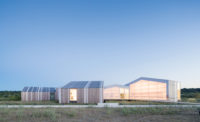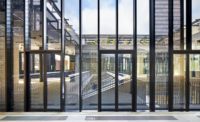St. Tropez, France
Christophe Pillet
Christophe Pillet has been designing objects and environments from his eponymous studio in Paris since 1993. Lately, though, he is becoming something of an authority on the “visual” nuances of alcohol by designing places and things that define a somewhat elite ritual of drinking. Earlier this fall Rémy Martin launched Pillet’s Les Lumiéres collection of vessels and presentation pieces for its Louis XIII Cognac. Appropriately, he took his design cues from the interaction between light and his material palette—specifically crystal, stainless steel, acrylic glass. Likewise, for his recent renovation of Bar du Port, a sliver-like 1,600-square-foot restaurant located on the Saint Tropez waterfront—Pillet again looked to the light for inspiration. “We are right in front of this charming harbor, where these super-luxurious yachts are parked and the light is amazing all day long,” he says. “I really wanted this image to come into the space.”
Pillet knows Bar du Port well. When its owner, Gregoire Chaix, inherited his family’s then-37-year-old restaurant in 2000, he hired Pillet to undertake the first renovation of the space since its original opening. At the time, the designer, who spent his childhood in the south of France, wanted to create a counterpoint to the Parisian-looking bistros found all around the port. The result offered a contemporary interpretation of regional style that Pillet calls “peaceful, silent, and in keeping with Saint Tropez.” Just seven years later, he recalls, “We decided we were bored, and Gregoire wanted something more powerful and international in style—for those party people who sail in from Russia and the U.S.” The “new” bar reopened this past March, marking the start of Saint Tropez’s high season.
Pillet says the all-white palette is meant to remind patrons of the yachts from which they’ve just alighted. The interior lighting, too, approximates this luxurious seafaring life. The front of house, a cafe area in which a banquette runs down either side of the rectangular plan, evokes the experience of a ship’s upper deck: All seating is bar-height to ensure that visitors can glimpse the harbor. Moreover, a high ceiling is largely clad in smoked mirror, amplifying daylight levels in the room and reflecting images of the boats “without being aggressive, vulgar,” Pillet says, “It’s something abstract.” At night, halogen downlights tucked around this plane of smoked mirrors cast narrow beams down the perimeter wall, which comprises vertical limestone planks of varying depths as well as expanses of plain mirror. The mood is intimate, Pillet notes, in contrast to the expansive daytime atmosphere.
Intimacy is the rule rather than the exception in the rear, where a long bar runs along its axis ending with a shorter coffee bar perpendicular to it. Here, the smoked-mirror ceiling drops significantly evoking the effect of a yacht captain’s cabin. Meanwhile, three 8-foot-high panels containing LEDs line the limestone wall opposite the bar and serve as figurative portholes. These ostensible screens cycle through washes of colors that resemble the sky and they occasionally flash low-resolution, computer-generated images of sharks, all of which multiplies in the ceiling and in the mirrors mounted just above the banquettes. According to Pillet, “I’m not interested in making patterns or decoration. So I find solutions like making textures that interact with the light.” Mention the LED panels and Pillet credits Parisian graphic artists Tom & Léo for devising the images.
Clearly, the designer is not interested in over-dynamic surfaces. “I am more interested in taking a scenographic approach to interiors and architecture,” he explains. “Light is a powerful system for striking emotions, for transforming the vision of a space. If you use light as an essential ingredient of perception, you don’t need much other material.”




Post a comment to this article
Report Abusive Comment